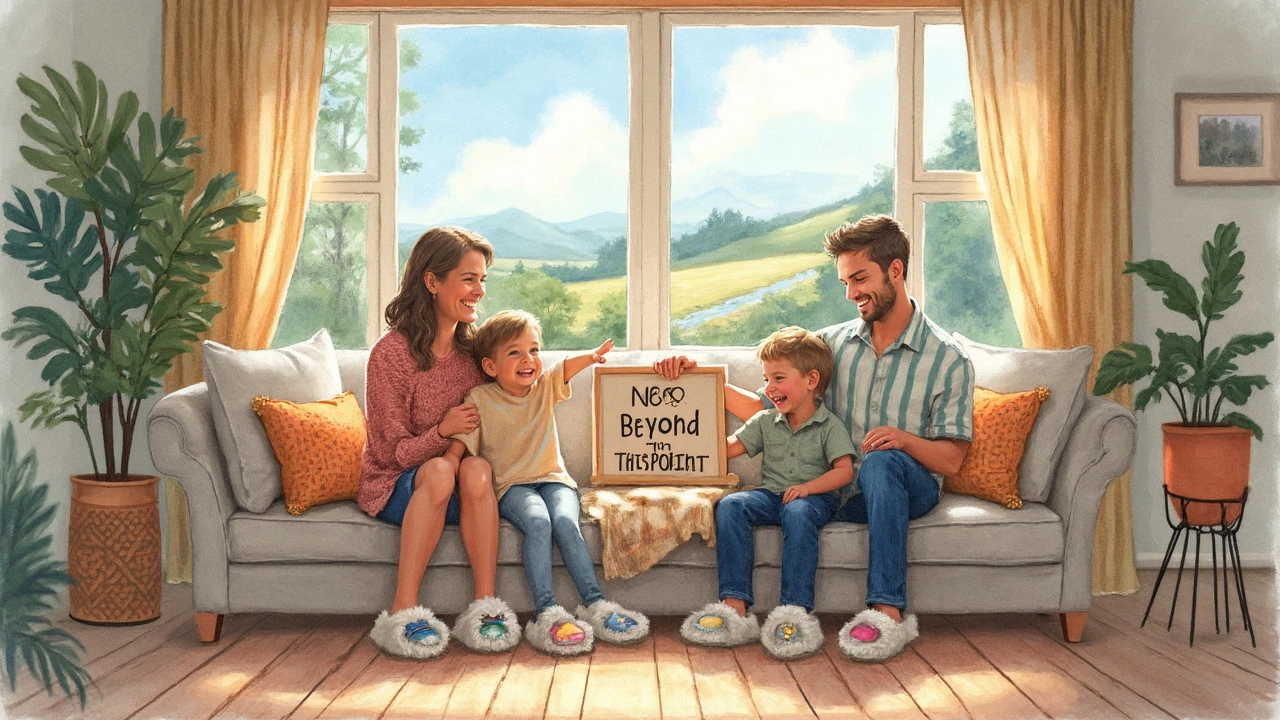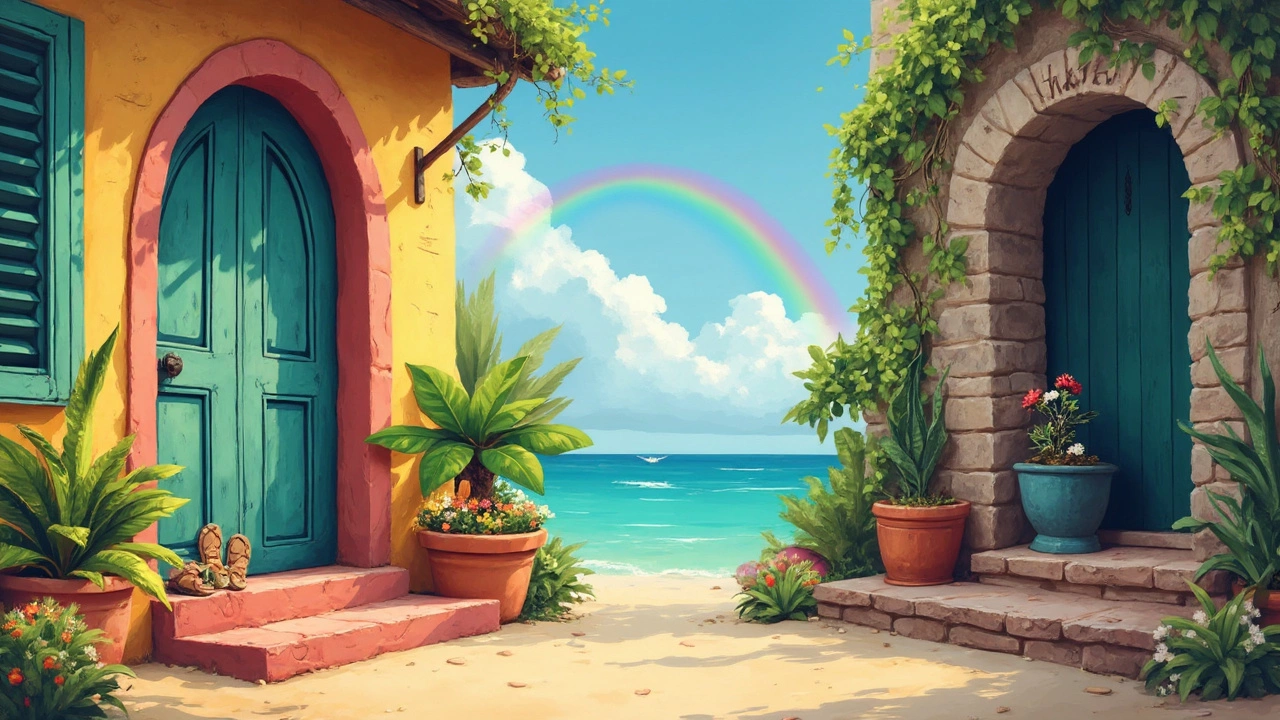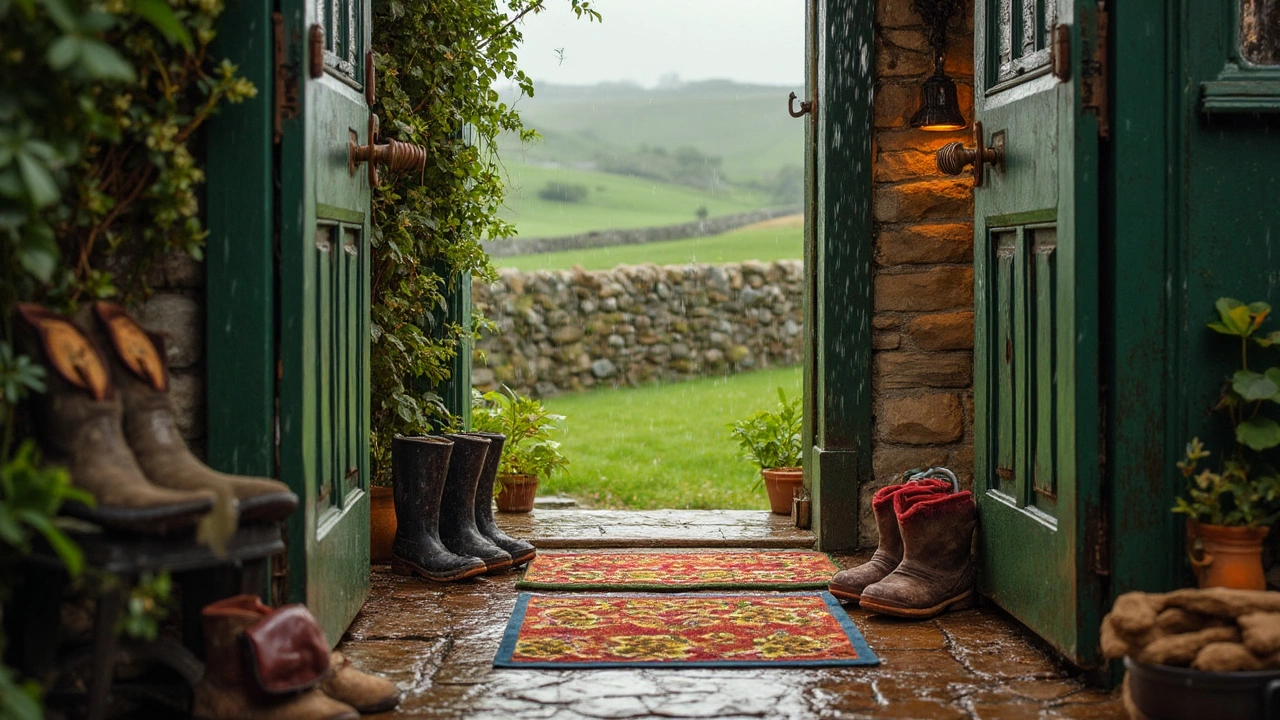Walk into a house in Ireland on a rainy day—say, after a weekend stroll through Phoenix Park—and odds are good you’ll crunch over a welcome mat and carry the outside world right into the hallway. Not everyone in Ireland has a set rule on shoes indoors, but have you ever stopped to think why Hawaiians are so strict about ditching shoes at the door?
This isn’t just a quirk from a faraway island. Hawaiians believe wearing shoes in the house is a no-go for keeping the indoors clean, calm, and free from bad vibes. And when you consider the constant drizzle and muck from Irish weather, you have to wonder if this would make life simpler for Irish households too. Ever stepped onto cold tile in the morning and wished you had better slippers? That’s where the Hawaiian custom starts to make sense, not just for heat but for hygiene and comfort.
In Irish towns like Kilkenny or Galway, families often invest in sturdy doormats, but proper house slippers—especially the kind made for wet climates—are catching on. The next sections will break down the Hawaiian 'no shoes' tradition, how it lines up with Irish habits, and why swapping to slippers could just save your floors, whether you’re cleaning up after a muddy rugby match or a Sunday hike in Wicklow.
- How Hawaiians See Shoes Indoors
- What Irish Households Usually Do
- Hygiene and Home Comfort: Pros and Cons
- Finding the Right Slippers for Irish Weather
- Tips for Adopting a No-Shoes Policy in Ireland
How Hawaiians See Shoes Indoors
If you land in Hawaii, one thing sticks out right away: shoes get left outside. This isn’t just a holiday tradition—it’s how most homes run, whether you’re visiting grandparents or popping by a mate’s flat. For Hawaiians, it’s a sign of respect. Shoes carry all sorts of grime and bacteria from the street—think sand, mud, and whatever you step on in sweaty heat—so nobody wants that in a clean home. This is about hygiene, but also about making people feel relaxed and at ease.
Leaving your shoes at the door in Hawaii is so normal that you’ll often spot a pile of 'slippahs' (their word for flip-flops) right outside every house. Guests know the drill; they kick their shoes off without being asked. And it isn’t about being fancy. Old slippers, rubber flip-flops, even bare feet—they’re all cool as long as outside dirt stays outside.
This tradition lines up with other Asian and Pacific cultures, which influenced Hawaii through migration and history. There, shoes are seen as dirty and leaving them off indoors keeps family—and any spirits that might be hanging about—happy and protected. Many Hawaiian families pass this habit down, so even kids get the hang of it before they’re out of nappies.
- Hygiene: The focus is keeping the house clean—makes sense on an island where people are in and out all day in humid weather.
- Respect: Taking off shoes shows respect for the home and its owners.
- Comfort: Nobody wants to track sand and mud through the living room or ruin a brand-new carpet.
Fun fact for readers in Ireland: a University of Arizona study actually found shoes can carry up to 400,000 bacteria a few days after wearing. That number beats out most bathroom surfaces, so you can see why Hawaiians stick to their rule.
This strict no-shoes policy isn’t about being strict for the sake of it. It’s a quick, low-tech way to keep living spaces healthy and always ready for friends to drop by for a cuppa or watch a game together.
What Irish Households Usually Do
If you’ve visited homes across Ireland, you’ll know there’s no nationwide rule about shoes indoors. Some Irish families are sticklers for leaving boots at the door, especially in the countryside where muck and sheep droppings are all too common. In cities like Dublin, rules can be a lot more relaxed. People wear shoes indoors, but many still step out of them, especially during wet months.
The classic hallway in an Irish house often has a pile of wellies or trainers next to the doormat. This isn’t just tradition; it’s pure practicality. Ireland’s unpredictable weather means shoes pick up a heap of dirt. Most people don’t fancy scrubbing the floors every day, so a lot of families politely ask guests to pop off their shoes on arrival. Some homes go the extra mile with a designated shoe rack or provide a basket of slippers for visitors—a trend picking up in bigger towns and B&Bs.
But Ireland isn’t Hawaii. Here, you’ll also find plenty of folks who don’t mind shoes inside, especially during gatherings or family events. There’s no social expectation to bring slippers—unlike in places like Japan or, you guessed it, Hawaii. If you visit a friend’s house in Cork or Sligo and keep your shoes on, nobody bats an eyelid, but it’s not unusual to be handed a pair of cosy house slippers either, especially in winter when tile floors are freezing.
- In suburban homes, especially around Galway or Limerick, mudrooms and shoe benches are growing more popular, making it easier to manage who wears what indoors.
- Apartment blocks in Dublin often have less space, so hallway shoe racks are popular. Sharing a flat? People usually sort it amongst themselves—some love slippers, some don’t bother.
If you’re renting via Daft.ie, you might even see landlords mentioning "no outdoor shoes inside" in the house rules. It depends on how picky your landlord is, or how new the floors are. For families with young kids, it’s nearly always shoes off, to keep things cleaner and a bit safer.
| Location | Shoes Off? |
|---|---|
| Rural cottages | Mostly yes |
| Dublin apartments | Depends/negotiable |
| Family homes with kids | Usually yes |
| Social gatherings | Often shoes on |
So, while Irish households aren’t as strict as Hawaiians, the idea of swapping shoes for slippers—especially in winter—makes a lot of sense for keeping homes clean and snug. If you’re thinking of going the slippers Ireland route, you’d fit right in, no matter where you hang your hat.

Hygiene and Home Comfort: Pros and Cons
There’s no tip-toeing around it: leaving shoes at the door, like Hawaiians do, brings real hygiene perks, especially in wet places like Irish homes. Shoes pick up germs, dirt, and whatever else is on the path from Moore Street to the Dart. Once you track all that in, no amount of hoovering on a Saturday morning can truly keep it at bay.
One research study from the University of Arizona found over 400,000 bacteria on the outside of an average shoe. Some of those, like E. coli, can wind up on your floors and rugs. Plenty of parents around Ireland are starting to realize this, especially with little kids or babies crawling about. Dr. Charles Gerba, the microbiologist behind that study, put it simply:
“Shoes are a public transport for microbes. More germs are spread in the home by shoes than most people think.”
What about comfort? Irish winters can chill you to your bones—anyone who’s hopped out of bed onto freezing tiles knows the feeling. Swapping out outside shoes for cosy slippers makes home life warmer and easier on the feet, especially if you’re padding around the kitchen making a cuppa or watching the late match in the lounge.
Of course, there are a few downsides. In busy Irish households, keeping a pile of slippers or spare socks near the door can get messy. And if you’re hosting mates over for the big game, you might hear a few grumbles about the "no shoes" policy. Plus, quick trips to the wheelie bin or garden can mean a bit of faffing around with footwear.
Here’s a rough look at how shoes stack up against slippers for hygiene and comfort in Ireland:
| Outside Shoes | Slippers/No Shoes | |
|---|---|---|
| Hygiene | Can bring in bacteria, pollen, dog mess | Far less dirt enters, easier for allergy sufferers |
| Comfort | Cold floors, not ideal for relaxing | Warmth, especially if buying good Irish brands like Dubarry |
| Convenience | Easy for dashing outside, but messier floors | Cleaner floors, a bit slower for outdoor jobs |
If you want to cut down on cleaning, keep allergies at bay, and make life at home a tad cosier, taking a page from Hawaiian tradition just makes sense in the Irish climate. It’s a small change, but the upsides for home comfort can be massive.
Finding the Right Slippers for Irish Weather
If you’ve lived in Irish homes through a single winter, you’ll know chilly floors are no joke. With Ireland’s rainfall and stone or tile flooring being fairly common (especially in places like rural Donegal or coastal Cork), picking out slippers isn’t as simple as grabbing the first fluffy pair on sale at Dunnes or Penneys.
You want slippers in Ireland that can handle damp, cold, and the odd quick dash to put out the bins when it’s drizzling. Classic Hawaiian flip-flops (they call them "slippahs") are a non-starter here. You need warmth and a bit of grip. Here’s what to look for:
- Water-resistant soles: Even inside, you’ll want slippers that won’t soak up every drop if someone traipses through after letting the dog out. Rubber or tough EVA soles work well for this. Shoemakers like Skechers and Vionic sell options that last through Irish winters.
- Insulated linings: Go for sheepskin, thick fleece, or even memory foam. The brands JustSheepskin and Dearfoams are popular around Leinster and often go on sale at Brown Thomas (especially near Christmas).
- Secure fit: Give open-back slippers a pass if you’re always on the go indoors. The traditional moccasin or bootie-style slippers hug your feet and keep out drafts.
- Washable: Irish mud seems to have a life of its own. Slippers that can go in the machine, like those from Celtic & Co or even Lidl’s winter specials, are a life-saver. Check the label before you buy.
To help compare what’s out there, here’s a glance at some of the most popular types locals buy, especially when the forecast calls for sideways rain:
| Slipper Type | Warmth | Water Resistance | Avg. Price (€) |
|---|---|---|---|
| Sheepskin moccasin | High | Medium | 40–80 |
| Memory foam clog | Medium | Low-Medium | 15–30 |
| Bootie-style slipper | Very High | Medium | 25–60 |
| Basic open-back | Low | Low | 10–20 |
And here’s a tip: don’t be afraid to keep an extra set by the back door for guests—especially if they just came in from a rainy football match or festival. More and more Irish families are adopting this little home etiquette trick, especially as good quality slippers are easy to find on the Irish market now. So next time you eye those half-price deals at Arnotts or see a neighbour in a cheerful pair from Avoca, remember: happy feet make for a happier house, no matter how grey the sky gets.

Tips for Adopting a No-Shoes Policy in Ireland
Thinking of ditching outdoor shoes in the house just like Hawaiians? Good shout, especially if you’re tired of sweeping up mud from back gardens or cleaning footprints after a walk along Howth Head. Getting everyone in the house (or your mates) onboard in Ireland isn’t tricky, but the key is in the details.
- Set the tone at the door. If you want friends and family to follow your no-shoes rule, a clear nudge helps. Put a sign up at the door—something friendly, not bossy. You can even get witty ones at shops in Liffey Valley or order a custom doormat online.
- Give people a place for shoes. Add a shoe rack or tray near the main entrance. IKEA Ballymun stocks plenty of affordable racks perfect for Irish homes where hallway space might be tight.
- Offer house slippers. This one’s key for both comfort and hygiene. Keep a basket of washable slippers by the door for guests—especially important with Ireland’s knack for chilly floors. Big brands like Dunnes and Penneys often have warm, budget-friendly options. Just pick styles you’d actually wear.
- Keep slippers hygienic. Stick to washable pairs or pop them in the machine regularly. Most people in Ireland wear slippers for a large chunk of the day at home, so give them a clean as often as your socks.
- Explain the policy kindly. Some folks—especially older relatives—might not be used to the idea. Explain you’re keeping the floors clean or just trying out a Hawaiian-inspired tradition. Most will get it.
If you’re worried about the floors getting cold, especially in older homes with stone or tile, try slippers with memory foam or even those lined with fleece. They’ll make winter mornings on Irish floors bearable. For bigger households or busy rental homes, colour-code slippers for each person—no more mix-ups, and it helps keep germs at bay.
One thing to note—dirt from outside can carry bacteria, and a 2023 Irish EPA report said outside germs often make their way inside just from folks walking in wearing shoes. Switching to house-only slippers not just keeps carpets looking better, but can improve indoor air quality too.
Here’s a quick look at how a household in Ireland might set up a no-shoes rule:
| What to Do | Irish Tip |
|---|---|
| Shoe rack at entry | Pick one to fit Irish hallways, like IKEA TJUSIG |
| Washable slippers | Get multi-packs from Penneys or Argos |
| No-shoes sign | DIY with Irish sayings for the craic |
| Regular slipper wash | Pop them in a 40°C wash—most brands are fine with it |
Start small—just the family at first—then see how it goes with visitors. You might be surprised how fast everyone gets onboard with this little slice of Hawaiian home etiquette right in the heart of Ireland.
